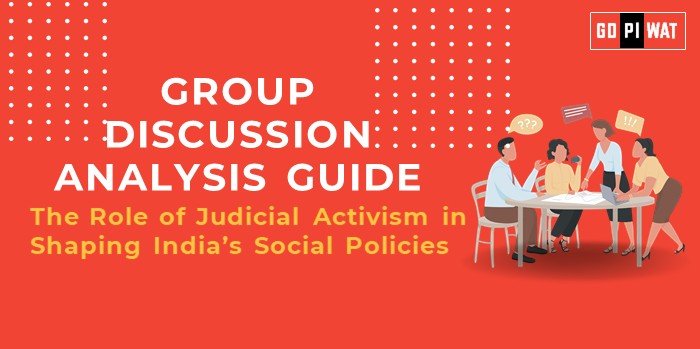📋 Group Discussion (GD) Analysis Guide: The Role of Judicial Activism in Shaping India’s Social Policies
🌐 Introduction to Judicial Activism in India
- 💬 Opening Context: Judicial activism, where courts interpret laws beyond their literal meaning to uphold justice, has been pivotal in shaping social policies in India. From environmental protection to gender equality, judicial intervention often sets transformative precedents.
- 📜 Topic Background: Emerging in the post-Emergency era, judicial activism in India gained momentum with Public Interest Litigations (PILs) in the 1980s. It allows citizens to directly approach the judiciary for redressal, significantly impacting policies like education, health, and social equity.
📊 Quick Facts and Key Statistics
- 📚 PIL Introduction: Initiated in the 1980s to ensure access to justice for marginalized groups.
- 🎓 Right to Education Act Enforcement: Supreme Court rulings ensured free education as a fundamental right.
- 🌍 Environmental Judgments: India has over 3,500 environment-related rulings, leading globally in judicial environmental activism.
- ⚖️ Social Equity Cases: Landmark cases like Vishaka vs. State of Rajasthan set workplace harassment guidelines.
🔍 Stakeholders and Their Roles
- ⚖️ Judiciary: Interprets laws and addresses policy gaps.
- 🏛️ Legislature: Enacts laws, sometimes influenced by judicial directives.
- 👥 Citizens & NGOs: Use PILs to address societal issues.
- 🏢 Government Agencies: Implement judicial directives in policies like pollution control and social justice.
🏆 Achievements and Challenges
Achievements:
- 🌊 Environmental Protection: Ganga Action Plan stemmed from judicial orders to clean the river.
- 🏳️🌈 Social Justice: Decriminalization of Section 377 ensured LGBTQ+ rights.
- 📚 Educational Reform: Enforcement of the midday meal scheme improved school attendance.
Challenges:
- ⚖️ Judicial Overreach: Blurring lines between judiciary and legislature.
- ⏳ Delayed Implementation: Compliance with rulings is inconsistent.
- 🌍 Global Comparisons: Unlike India, nations like the US rely on broader executive actions for social policies.
🎯 Structured Arguments for Discussion
- ✅ Supporting Stance: Judicial activism bridges gaps in legislative action, fostering inclusivity and equity.
- ⚖️ Opposing Stance: Overreach undermines legislative authority, creating governance friction.
- 🤝 Balanced Perspective: While judicial activism drives reform, a collaborative approach with the legislature ensures sustained impact.
🗣️ Effective Discussion Approaches
- 📊 Opening Approaches:
- “Judicial activism is the cornerstone of transformative justice, evident in the enforcement of socio-economic rights.”
- “From the Vishaka Guidelines to environmental directives, courts shape India’s social policy trajectory.”
- 🔄 Counter-Argument Handling: Acknowledge overreach concerns and propose synergy between judiciary and legislature for better governance.
🔍 Strategic Analysis: SWOT
- 💪 Strengths: Inclusive justice, checks legislative gaps.
- 🔧 Weaknesses: Implementation delays, perceived overreach.
- 🌟 Opportunities: Enhance global human rights stature.
- ⚠️ Threats: Potential politicization of judicial decisions.
💼 Connecting with B-School Applications
Real-World Applications: Policy analysis on judicial decisions in finance, education, or health sectors.
Sample Questions:
- 💡 “How does judicial activism shape public policies in India?”
- 💡 “Analyze the impact of PILs on societal reforms.”
Insights for Students: Study judicial policies for internship projects in governance or public administration, focusing on how judicial interventions can lead to policy innovation.


